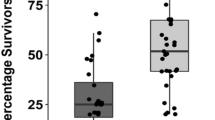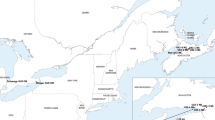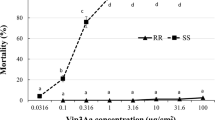Abstract
Evolution of insect resistance threatens the continued success of transgenic crops producing Bacillus thuringiensis (Bt) toxins that kill pests. The approach used most widely to delay insect resistance to Bt crops is the refuge strategy, which requires refuges of host plants without Bt toxins near Bt crops to promote survival of susceptible pests. However, large-scale tests of the refuge strategy have been problematic. Analysis of more than a decade of global monitoring data reveals that the frequency of resistance alleles has increased substantially in some field populations of Helicoverpa zea, but not in five other major pests in Australia, China, Spain and the United States. The resistance of H. zea to Bt toxin Cry1Ac in transgenic cotton has not caused widespread crop failures, in part because other tactics augment control of this pest. The field outcomes documented with monitoring data are consistent with the theory underlying the refuge strategy, suggesting that refuges have helped to delay resistance.
This is a preview of subscription content, access via your institution
Access options
Subscribe to this journal
Receive 12 print issues and online access
$209.00 per year
only $17.42 per issue
Buy this article
- Purchase on Springer Link
- Instant access to full article PDF
Prices may be subject to local taxes which are calculated during checkout


Similar content being viewed by others
References
Gould, F. Sustainability of transgenic insecticidal cultivars: integrating pest genetics and ecology. Annu. Rev. Entomol. 43, 701–726 (1998).
U.S. Environmental Protection Agency. The Environmental Protection Agency's White Paper on Bt Plant-Pesticide Resistance Management (EPA Publication 739-S-98–001) (Environmental Protection Agency, Washington, DC, USA, 1998). <http://www.epa.gov/EPA-PEST/1998/January/Day-14/paper.pdf>
Tabashnik, B.E. Evolution of resistance to Bacillus thuringiensis. Annu. Rev. Entomol. 39, 47–94 (1994).
Tabashnik, B.E. et al. Insect resistance to transgenic Bt crops: lessons from the laboratory and field. J. Econ. Entomol. 96, 1031–1038 (2003).
James, C. Global status of commercialized biotech/GM crops: 2006. ISAAA Briefs 35, 1–9 (2006).
National Research Council. Pesticide Resistance: Strategies and Tactics for Management (National Academy Press, Washington, DC, USA, 1986).
Luttrell, R.G., Wan, L. & Knighten, K. Variation in susceptibility of Noctuid (Lepidoptera) larvae attacking cotton and soybean to purified endotoxin proteins and commercial formulations of Bacillus thuringiensis. J. Econ. Entomol. 92, 21–32 (1999).
Ali, M.I., Luttrell, R.G. & Young, S.Y. III Susceptibilities of Helicoverpa zea and Heliothis virescens (Lepidoptera: Noctuidae) populations to Cry1Ac insecticidal protein. J. Econ. Entomol. 99, 164–175 (2006).
Janmaat, A.F. & Myers, J.H. Rapid evolution and the cost of resistance to Bacillus thuringiensis in greenhouse populations of cabbage loopers, Trichoplusia ni. Proc. R. Soc. Lond. B 270, 2263–2270 (2003).
Luttrell, R.G. & Ali, M.I. Exploring selection for Bt resistance in Heliothines: results of laboratory and field studies. in Proceedings of the 2007 Beltwide Cotton Conferences, New Orleans, Louisiana, January 9–12, 2007, 1073–1086 (National Cotton Council of America, Memphis, Tennessee, USA, 2007).
Burd, A.D., Gould, F., Bradley, J.R., Van Duyn, J.W. & Moar, W.J. Estimated frequency of nonrecessive Bt resistance genes in bollworm, Helicoverpa zea (Boddie) (Lepidoptera: Noctuidae) in eastern North Carolina. J. Econ. Entomol. 96, 137–142 (2003).
Jackson, R.E., Gould, F., Bradley, J.R. Jr., & Van Duyn, J.W. Genetic variation for resistance to Bacillus thuringiensis in Helicoverpa zea (Lepidoptera: Noctuidae) from eastern North Carolina. J. Econ. Entomol. 99, 1790–1797 (2006).
Gustafson, D.I., Head, G.P. & Caprio, M.A. Modeling the impact of alternative hosts on Helicoverpa zea adaptation to Bollgard cotton. J. Econ. Entomol. 99, 2116–2124 (2006).
Burd, A.D., Bradley, J.R. Jr.,, Van Duyn, J.W. & Gould, F. Resistance of bollworm, Helicoverpa zea, to CryIA(c) toxin. in Proceedings of the 2000 Beltwide Cotton Conferences, San Antonio, Texas, January 4–8, 2000 (eds. Dugger, C.P. & Richter, D.A.) Vol. 2: 923–926 (National Cotton Council of America, Memphis, Tennessee, USA, 2000).
Downes, S., Mahon, R. & Olsen, K. Monitoring and adaptive resistance management in Australia for Bt-cotton: current status and future challenges. J. Invertebr. Pathol. 95, 208–213 (2007).
Wu, K. Monitoring and management strategy of Helicoverpa armigera resistance to Bt cotton in China. J. Invertebr. Pathol. 95, 220–223 (2007).
Carrière, Y. et al. Long-term evaluation of compliance with refuge requirements for Bt cotton. Pest Manag. Sci. 61, 327–330 (2005).
Farinós, G.P., de la Poza, M., Hernández-Crespo, P., Ortego, F. & Castañera, P. Resistance monitoring of field populations of the corn borers Sesamia nonagrioides and Ostrinia nubilalis after 5 years of Bt maize cultivation in Spain. Entomol. Exp. Appl. 110, 23–30 (2004).
Jackson, R.E., Bradley, J.R. Jr., & Van Duyn, J.W. Performance of feral and Cry1Ac-selected Helicoverpa zea (Lepidoptera: Noctuidae) strains on transgenic cottons expressing either one or two Bacillus thuringiensis ssp. kurstaki proteins under greenhouse conditions. J. Entomol. Sci. 39, 46–55 (2004).
Jackson, R.E., Bradley, J.R. Jr.,, Van Duyn, J.W. & Gould, F. Comparative production of Helicoverpa zea (Lepidoptera: Noctuidae) from transgenic cotton expressing either one or two Bacillus thuringiensis proteins with or without insecticide oversprays. J. Econ. Entomol. 97, 1719–1725 (2004).
Luttrell, R.G. et al. Resistance to Bt in Arkansas populations of cotton bollworm. in Proceedings of the 2004 Beltwide Cotton Conferences, San Antonio, Texas, January 5–9, 2004 (ed. Richter, D.A.) 1373–1383 (National Cotton Council of America, Memphis, Tennessee, USA, 2004).
Monsanto Co. Monsanto biotechnology trait acreage. Fiscal years 1996 to 2007 (Monsanto, St. Louis, updated October 10, 2007) http://www.monsanto.com/investors/presentations.asp; scroll down to Biotech Acres under Fourth-Quarter 2007 Monsanto Company Earnings Conference Call).
Zhao, J.-Z. et al. Concurrent use of transgenic plants expressing a single and two Bacillus thuringiensis genes speeds insect adaptation to pyramided plants. Proc. Natl. Acad. Sci. USA 102, 8426–8430 (2005).
Siegfried, B.D., Vaughn, T.T. & Spencer, T. Baseline susceptibility of western corn rootworm (Coleoptera: Crysomelidae) to Cry3Bb1 Bacillus thuringiensis toxin. J. Econ. Entomol. 98, 1320–1324 (2005).
Baum, J.A. et al. Control of coleopteran insect pests through RNA interference. Nat. Biotechnol. 25, 1322–1326 (2007).
Mao, Y.-B. et al. Silencing a cotton bollworm P450 monooxygenase gene by plant-mediated RNAi impairs larval tolerance of gossypol. Nat. Biotechnol. 25, 1307–1313 (2007).
Soberón, M. et al. Engineering modified Bt toxins to counter insect resistance. Science 318, 1640–1642 (2007).
Tabashnik, B.E., Dennehy, T.J. & Carrière, Y. Delayed resistance to transgenic cotton in pink bollworm. Proc. Natl. Acad. Sci. USA 102, 15389–15393 (2005).
Bird, L.J. & Akhurst, R.J. Variation in susceptibility of Helicoverpa armigera (Hübner) and Helicoverpa punctigera (Wallengren) (Lepidoptera: Noctuidae) in Australia to two Bacillus thuringiensis toxins. J. Invertebr. Pathol. 94, 84–94 (2007).
Wu, K., Guo, Y. & Head, G. Resistance monitoring of Helicoverpa armigera (Lepidoptera: Noctuidae) to Bt insecticidal protein during 2001–2004 in China. J. Econ. Entomol. 99, 893–898 (2006).
Li, G.-P. et al. Increasing tolerance to Cry1Ac cotton from cotton bollworm, Helicoverpa armigera, was confirmed in Bt cotton farming area of China. Ecol. Entomol. 32, 366–375 (2007).
Gahan, L.J., Gould, F., López, J.D., Micinski, S. & Heckel, D.G. A polymerase chain reaction screen of field populations of Heliothis virescens for a retrotransposon insertion conferring resistance to Bacillus thuringiensis toxin. J. Econ. Entomol. 100, 187–194 (2007).
Stodola, T.J. et al. Frequency of resistance to Bacillus thuringiensis toxin Cry1Ab in southern United States corn belt populations of European corn borer (Lepidoptera, Crambidae). J. Econ. Entomol. 99, 502–507 (2006).
Tabashnik, B.E. et al. DNA screening reveals pink bollworm resistance to Bt cotton remains rare after a decade of exposure. J. Econ. Entomol. 99, 1525–1530 (2006).
Andreadis, S.S. et al. Frequency of resistance to Bacillus thuringiensis toxin Cry1Ab in Greek and Spanish population of Sesamia nonagrioides (Lepidoptera: Noctuidae). J. Econ. Entomol. 100, 195–201 (2007).
Acknowledgements
We are especially grateful to R. Luttrell, A. Mathias, W. Moar, D. Onstad, M. Sisterson and K. Wu for comments and suggestions. This work was supported by the National Research Initiative, the Cooperative State Research, Education, and Extension Service, and United States Department of Agriculture grant 2006-35302-17365.
Author information
Authors and Affiliations
Corresponding author
Ethics declarations
Competing interests
Although the preparation of this article was not supported by organizations that may gain or lose financially through its publication, the authors have received support for other research from Monsanto Co. and Cotton Incorporated. In addition, one of the authors (B.E.T.) is a coauthor of a patent application on engineering modified Bt toxins to counter pest resistance, which is related to published research (Science 318, 1640–1642, 2007).
Supplementary information
Rights and permissions
About this article
Cite this article
Tabashnik, B., Gassmann, A., Crowder, D. et al. Insect resistance to Bt crops: evidence versus theory. Nat Biotechnol 26, 199–202 (2008). https://doi.org/10.1038/nbt1382
Published:
Issue Date:
DOI: https://doi.org/10.1038/nbt1382
This article is cited by
-
Modeling fall armyworm resistance in Bt-maize areas during crop and off-seasons
Journal of Pest Science (2023)
-
Recent insights into pesticide resistance mechanisms in Plutella xylostella and possible management strategies
Environmental Science and Pollution Research (2023)
-
Biomolecules in modern and sustainable agriculture
3 Biotech (2023)
-
Silencing of multiple target genes via ingestion of dsRNA and PMRi affects development and survival in Helicoverpa armigera
Scientific Reports (2022)
-
Ectopic expression of Xenorhabdus nematophila chitinase in tobacco confers resistance against Helicoverpa armigera
Plant Cell, Tissue and Organ Culture (PCTOC) (2022)



